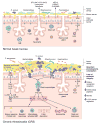A comprehensive review of the nasal microbiome in chronic rhinosinusitis (CRS)
- PMID: 26510171
- PMCID: PMC4715613
- DOI: 10.1111/cea.12666
A comprehensive review of the nasal microbiome in chronic rhinosinusitis (CRS)
Abstract
Chronic rhinosinusitis (CRS) has been known as a disease with strong infectious and inflammatory components for decades. The recent advancement in methods identifying microbes has helped implicate the airway microbiome in inflammatory respiratory diseases such as asthma and COPD. Such studies support a role of resident microbes in both health and disease of host tissue, especially in the case of inflammatory mucosal diseases. Identifying interactive events between microbes and elements of the immune system can help us to uncover the pathogenic mechanisms underlying CRS. Here we provide a review of the findings on the complex upper respiratory microbiome in CRS in comparison with healthy controls. Furthermore, we have reviewed the defects and alterations of the host immune system that interact with microbes and could be associated with dysbiosis in CRS.
© 2015 John Wiley & Sons Ltd.
Figures

References
-
- Anand VK. Epidemiology and economic impact of rhinosinusitis. The Annals of otology, rhinology & laryngology Supplement. 2004;193:3–5. - PubMed
-
- Pleis JR, Ward BW, Lucas JW. Summary health statistics for U.S. adults: National Health Interview Survey, 2009. Vital and health statistics Series 10, Data from the National Health Survey. 2010:1–207. - PubMed
-
- Gliklich RE, Metson R. The health impact of chronic sinusitis in patients seeking otolaryngologic care. Otolaryngology--head and neck surgery : official journal of American Academy of Otolaryngology-Head and Neck Surgery. 1995;113:104–109. - PubMed
-
- Bachert C, Gevaert P, van Cauwenberge P. Staphylococcus aureus enterotoxins: a key in airway disease? Allergy. 2002;57:480–487. - PubMed
-
- Shin SH, Ponikau JU, Sherris DA, Congdon D, Frigas E, Homburger HA, Swanson MC, Gleich GJ, Kita H. Chronic rhinosinusitis: an enhanced immune response to ubiquitous airborne fungi. The Journal of allergy and clinical immunology. 2004;114:1369–1375. - PubMed
Publication types
MeSH terms
Grants and funding
LinkOut - more resources
Full Text Sources
Other Literature Sources
Medical

